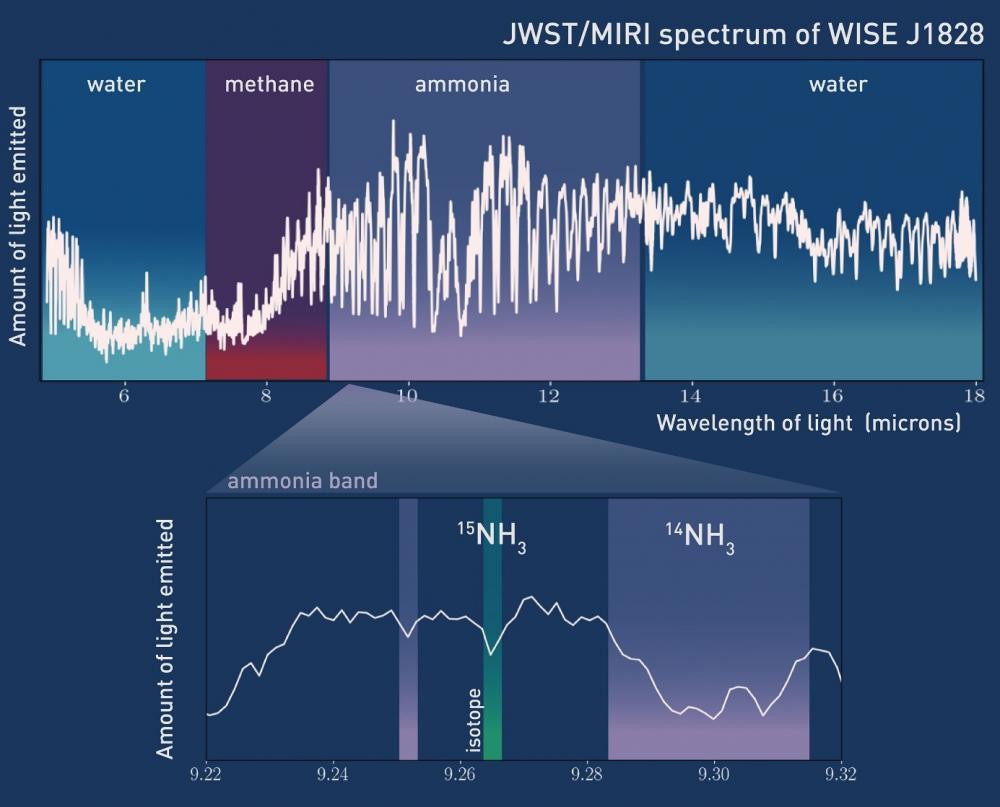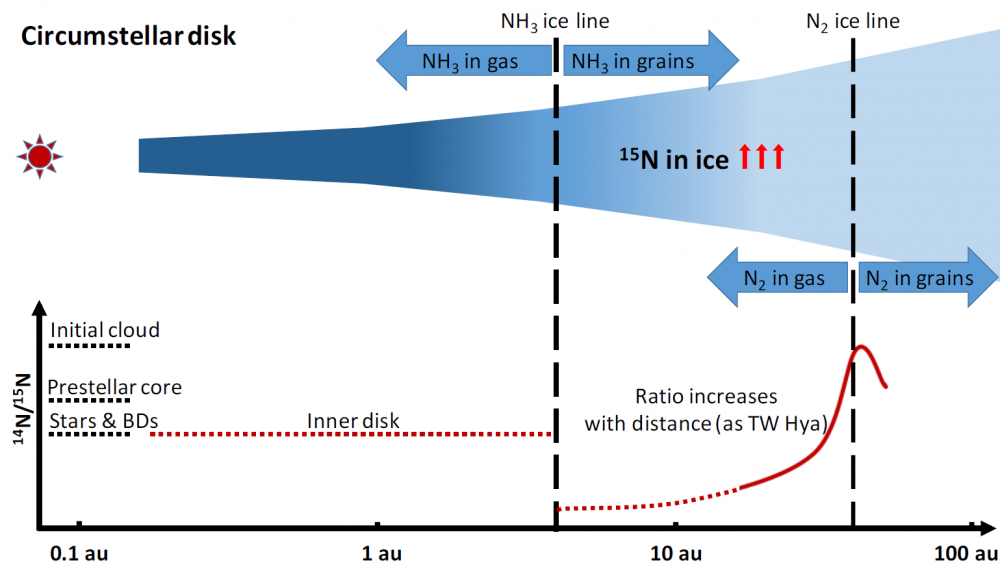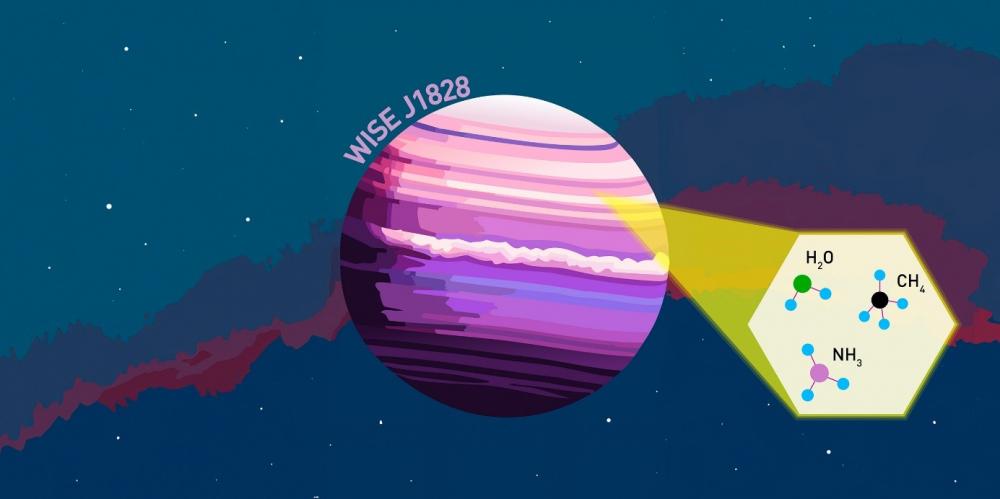The consortium of laboratories that has developed the MIRI instrument for the JWST is benefiting from guaranteed observation time. The CEA's Astrophysics Department, which is part of the consortium, has defined and coordinated the exoplanet observation programme. Among the objects selected are a number of brown dwarfs, which are excellent proxies for studying giant exoplanets, particularly those that orbit far from their star, much further away than the planets in our solar system. The physical and chemical processes that govern brown dwarfs are very similar. The first results concerning the cold brown dwarf W1828 have just been published in the journal Nature. By pointing the James Webb Space Telescope (JWST) at this object, a team of researchers including DAp-AIM researchers were able to use the MIRI instrument to measure, for the first time, the isotopologues of ammonia in the atmosphere of a cold brown dwarf, paving the way for a better understanding of the formation of exoplanets.
These results have been published in the journal Nature.
Brown dwarfs, stars between planets and stars
Brown dwarfs are celestial bodies located on the boundary between stars and planets. Their mass is insufficient to initiate thermonuclear fusion of hydrogen in their core, as stars do, but sufficient to initiate deuterium fusion, unlike planets. In many respects, these stars resemble gas giant planets, making them excellent laboratories for the study of exoplanets.
The brown dwarf WISE J1828 lies 32.5 light-years from Earth, in the constellation Lyra. Its radius is only a third that of Jupiter, while its mass is 15 times greater. With a surface temperature of just 100 degrees Celsius, it belongs to the Y spectral class, whose atmospheres are dominated by the absorption of water, methane and ammonia. At these temperatures, the light emission from these brown dwarfs peaks in the mid-infrared. The arrival of the JWST will revolutionise the study of these stars, as its MIRI (Mid-Infrared Instrument) infrared sensor covers their entire range of light, which was previously difficult to observe.

Figure 2: Spectrum of WISE J1828 measured by the MIRI instrument on board the JWST. The characteristic absorption bands of ammonia, water and methane molecules are clearly visible, causing signal attenuation in the wavelength range between 9 and 13 ?m, 5 and 7 µm, and around 7.6 µm respectively. The zoomed-in region of the spectrum shows an example of a 15NH3 absorption band identified with the resolution of the MIRI spectrometer.
Credit: ETH Zurich / Polychronis Patapis.
Crédit: ETH Zurich / Polychronis Patapis.
The ammonia isotope, a tracer of the formation of exoplanets
Isotopes are atoms that have the same number of protons but a different number of neutrons. Because of their different atomic masses, isotopes of the same element have different physical properties, and therefore different spectral signatures. They are widely used on Earth. One example is carbon-14 dating, which is used to estimate the age of bones or fossils.
In astronomy, they are playing an increasingly important role. For example, the ratio of carbon-12 (12C) and carbon-13 (13C) isotopes in the atmosphere of an exoplanet can be used to deduce the distance at which the exoplanet formed around its central star. Until now, 12C and 13C, bound in carbon monoxide, were the only isotopologues - molecules that differ only in the composition of their isotopes - that could be measured in the atmosphere of exoplanets. But for cold objects, it is very difficult to have access to these isotopic ratios.
Thanks to this new study, the team of researchers has demonstrated that it is also possible to use ammonia (NH3) isotopologues as a tracer of the formation of exoplanets. For the first time, they have detected in the atmosphere of a cold brown dwarf, used here as a proxy for exoplanets, the characteristic spectral signature of the presence of the molecules 14NH3 (also written 14N) and 15NH3 (15N). Although they differ by just one neutron in the nitrogen nucleus, we can clearly distinguish them in the observed spectrum (see Figure 2).
A new diagnostic tool for the formation of exoplanets
Gas giants such as Jupiter and Saturn not only exist in our solar system, but are also found in other exoplanetary systems. Some orbit very far from their star, and the question of how they formed arises. Did they form in the protostellar disc, like stars, through gravitational instability, or later in the protoplanetary disc? The 14NH3 / 15NH3 ratio is a tracer, i.e. an indicator, that could be used in the future to study the formation of these planets.
As shown in Figure 3, in a protoplanetary disc, the ratio of 14NH3 to 15NH3 depends on the distance from the star and increases sharply between the ammonia (NH3) ice line and the molecular nitrogen (N2) ice line. This variation is still very qualitative, but the trend is there.
In this respect, ammonia and the quantity of its isotopologues can provide information not only on how an exoplanet developed, but also on where in the protoplanetary disc it formed. The 14N/15N ratio can constrain the locations of formation in relation to the NH3 and N2 ice lines of the disc, making ammonia a new tool for understanding the formation of gas giants. This hypothesis could be tested on cold exoplanets far from their star, and thus directly imageable by the James Webb telescope.

Figure 3: This diagram summarises the different phases in the formation of stars and planets and the relationship between the fractionation of ammonia (NH3) and the evolution of the 14N/15N ratio at different stages: inside a molecular cloud with pre-stellar cores (top left), during the formation of a protostar (top right) and in a circumstellar disc around a young star (bottom).
Adapted from the article Barrado, D. et al. 15NH3 in the atmosphere of a cool brown dwarf. Nature (2023).
Crédit : adapté de l’article Barrado, D. et al. 15NH3 in the atmosphere of a cool brown dwarf. Nature (2023).
Contact DAp: Pierre-Olivier LAGAGE
• Structure and evolution of the Universe › Planets, star's formation and dynamics, interstellar medium
• Institute of Research into the Fundamental Laws of the Universe • Department of Astrophysics (DAp) // UMR AIM
• Laboratory Dynamics of Stars, Exoplanets and their Environment
• JWST



